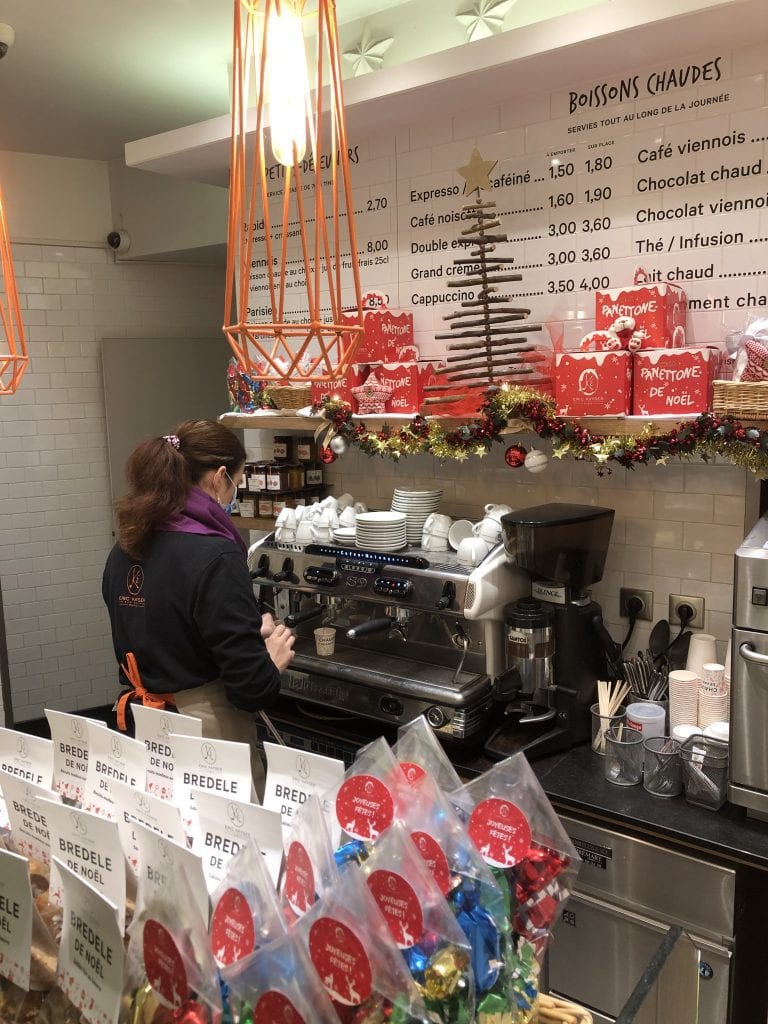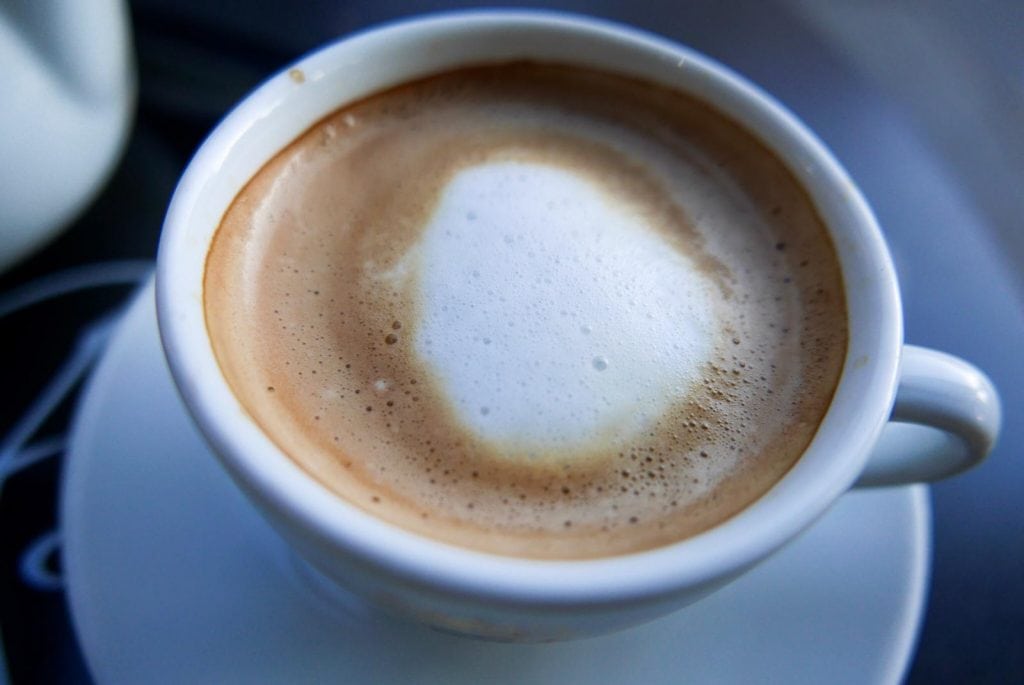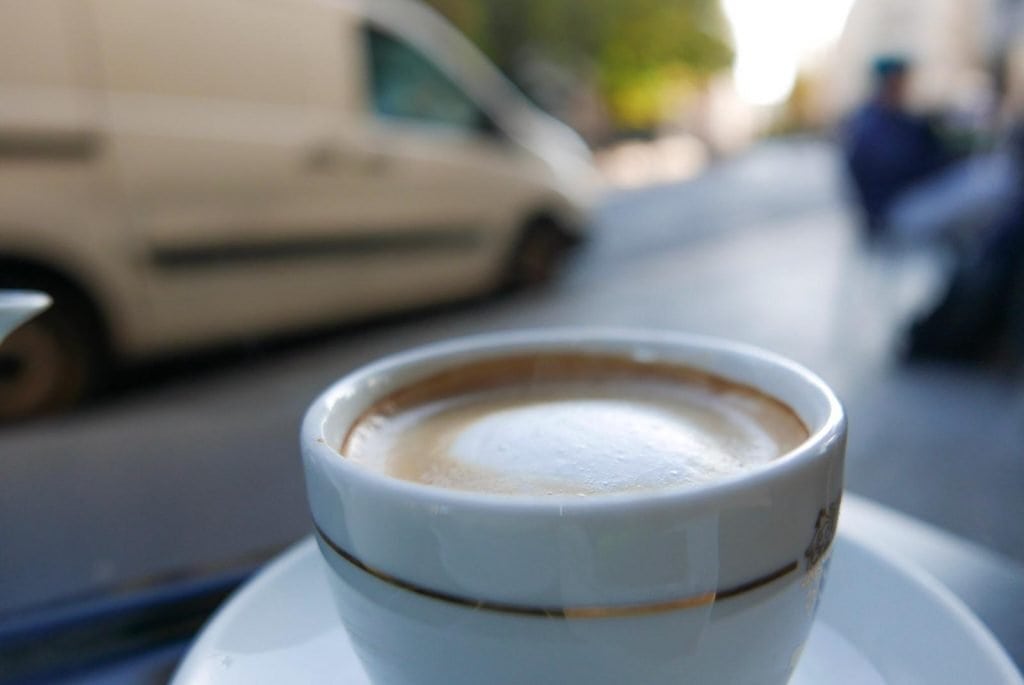How does café au lait differ from café latte? This question has nagged me for a long time. Sure, my rudimentary French education made it clear that both drinks include milk. But how are they different? Do they share any characteristics? Are they the same drink going by other names? Continue reading to find the answers to these questions and more!
I headed to Paris for a weekend getaway just before the winter blues set in, so I got the opportunity to find an answer to these questions firsthand. It was a cold morning in Paris. Not a single cloud hung in the intense blue sky. Workers milled about — burly men unloading crates off of trucks, business people in crisp suits hurrying along the sidewalks.
I was on vacation, however, and I had one thing on my mind, as is so often the case early in the morning: coffee. So I set off towards one of the best cafes in the city for café au lait: Boulangerie Eric Kayser in Paris’ Latin Quarter neighborhood.
Like most Parisian boulangeries, Eric Kayser is split into a pastry section and a small coffee bar. I blew past the pastries and headed straight to the back, where a single barista was whizzing about, fielding orders from the predominantly French clientele. I ordered my cafe au lait and began quizzing the barista about this distinctly French creation. Then, my attempt to untangle this milky mystery began.

Café au lait: Simply Add Milk

Picture Credit: Alec Siegel
Café au lait, sometimes called café misto, is “coffee with milk.” But this tells an incomplete picture, as that same description can apply to any number of coffee drinks. It will be no shock to learn that café au lait has its origins in France. Traditionally, people brew the coffee base of a café au lait using a French press or, less commonly, a dripper. Steamed milk is then added to the coffee and served in a small porcelain bowl. The coffee to brew ratio depends strongly on personal preference, but convention suggests using a part of steamed milk for each part of coffee.
This is the “pure” method of preparing and serving the oft-misunderstood drink. Today, however, the specifics can vary from place to place and barista to barista. For some, café au lait is simply a catch-all term that mistakenly refers to a cafe latte or other popular milk-infused coffee. Based on this confusion, many baristas across Europe and the United States serve up what is in effect a latte masquerading it as a café au lait. And of course, like nearly all other coffees today, it is served in a porcelain mug rather than the traditional cup.
Like many urban legends, the well-meaning but incorrect assumption that a café au lait is just coffee with milk contains a kernel of truth. In some coffee houses, a café au lait may indeed mirror a cafe latte – it is sometimes served as an espresso with steamed milk and foam on top. But the devil is in the details. The traditional formula is simple: drip coffee topped with equal parts steamed or heated milk.
That’s it! No espresso, no foam.
Cafe Latte: Very Dairy
Let’s cut straight to the point: a cafe latte is its own beast, though it does share some attributes with a cafe au lait. Despite the similar names – cafe latte means “coffee and milk” in Italian – these two drinks, at least in the eyes of discerning coffee consumers, are night and day. While the origins of this drink are not entirely clear, a cafe latte today is almost uniformly made with a shot of espresso and steamed milk, finished with a layer of foam and, of course, a floral design or some other fun doodle.
In fact, this may now be the most identifiable aspect of a latte. Baristas from Bangkok to Brooklyn finish off a latte with an artful twist; the foam is their canvas, the milk their paintbrush. Anime characters, historical figures, flora, fauna, and much more have been artfully drawn in latte foam.
When I tucked into my cafe au lait that frigid fall morning in Paris, the lack of latte art was the first thing I noticed. No milky white flower, just a cloudy caramel-colored liquid with a tiny trace of foam on top. And here is the rub – while both a cafe au lait and cafe latte contain milk in large quantities, a cafe latte is, to put it bluntly, the milkier of the two.
Both in its coffee to milk ratio, taste, and general aesthetic, drinking a cafe au lait feels like drinking a French press with a dollop of steamed milk. A proper cafe latte has the opposite effect – milk takes center stage, both taste and aesthetic. From the top layer of foam to the creamy bottom morsels, cafe lattes take the drinker on a milky journey from start to finish.
Intertwined Histories

Picture Credit: Alec Siegel
The detailed histories of the café au lait and cafe latte are cloudy. We know with certainty that Europeans have been sipping coffee since the 16th century, and we can surmise that they’ve been adding milk in some form to their brews beginning not long after.
The first person to discover the joy of milky coffee was Johan Nieuhof, the Dutch ambassador to China, around 1660. Nieuhof was inspired by the already widespread practice of tipping some milk in tea, according to the 1977 book Coffee: A Connoisseur’s Companion by Claudia Roden.
But from here, it’s all a bit milky. At around the same time as Nieuhof’s pivotal discovery, cafés began making their mark in Paris. We know for sure that the au lait is as French as croissants and baguettes. The first known mention of the drink appears in the letters of Marie de Rabutin-Chantal, a French aristocrat, in the mid-1600s. This tracks with the nascent French cafe culture of the time and the growing popularity of milky coffee. That said, the precise route from there to the cafe au lait we know and love today remains a mystery.
As for the cafe latte, Italians probably began combining heated milk and coffee around the same time as the French. But what we know of as the caffe latte – espresso with steamed milk topped with foam – could not have been fully formed until at least the early 20th century. Why? Because espresso, which makes for the crucial base of the drink, was not birthed until the early 20th century by Milanese businessman Luigi Bezzera.
We can make an educated guess that something like the latte was brewed and consumed in cafes across Italy since then. However, some coffee historians hypothesize that the commercial latte as sipped today – from specialty cafes in metropolises the world over to ubiquitous chains that fill highway rest stops – began in the United States.
The Diverse Spectrum of Milk Coffee Drinks
Milk coffees exist on a spectrum. As such, café au lait and caffe latte both occupy different perches along the milk coffee continuum, but both fall somewhere in the middle, between the one with the most milk (caffe latte) and the one with most coffee (macchiato).
Macchiato translates to “stained” or “marked” in Italian and is on one end of the milk coffee spectrum. Here, espresso dominates. A dollop of milk – usually foam – completes the drink; this is meant to complement, not dominate, the coffee. And on the other end, we have the latte, which has one shot of espresso mixed with two parts of frothy milk.
The mantra for distinguishing between the wide variety of milk coffee drinks is simple: ratio, ratio, ratio.
It all depends on the ratio between coffee –whether espresso-based or drip– and milk. A café au lait is balanced, containing equal parts coffee and milk; lattes skew more towards the milk, especially when considering the drink’s frothy finish.
Conclusion: To Each Their Own
I left Eric Kayser with a belly full of coffee and pain au chocolat. As I meandered around the Tuileries Gardens, I thought over everything I had learned earlier that morning. What is a cafe au lait? Simple: drip coffee with steamed milk. But this is cafe au lait in its more traditional form.
In reality, in the world where coffee is consumed today, it means coffee with milk. Go to a cafe in New York or Tokyo, and you’re likely to stumble across a well-meaning barista who prepares an au lait just like a latte, with espresso, a generous serving of steamed milk, and foam.
Definitions change and adapt to the times. In Paris, a barista who is well-versed in history and strictly adheres to the letter of coffee law, like the one I encountered at Eric Kayser, will serve up the same cafe au lait French drinkers tasted hundreds of years ago. Others will prepare what is in effect a latte. The lesson is this: no matter the coffee-milk ratio or whether or not there’s foam on top, appreciate each cup for the milky miracle that it is.


